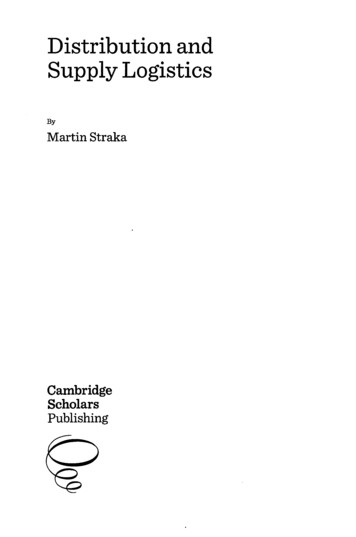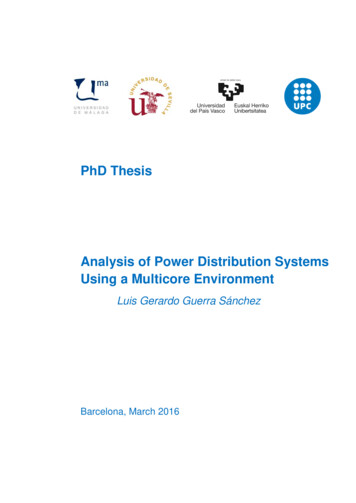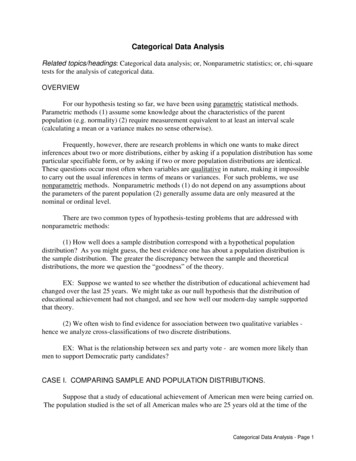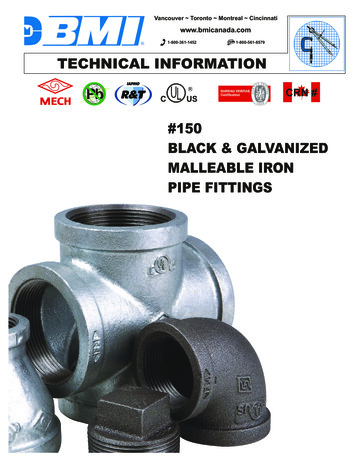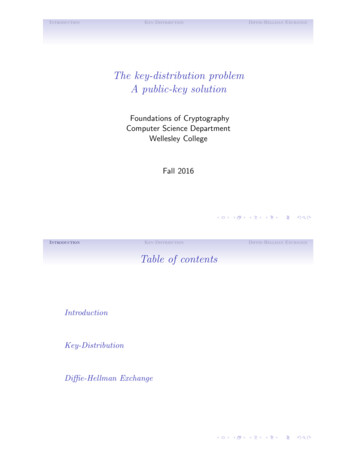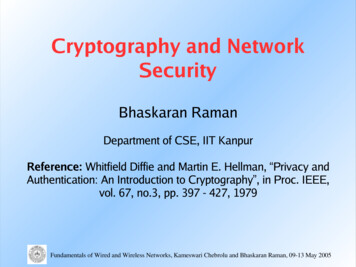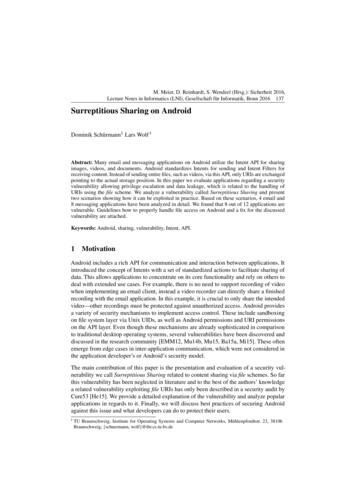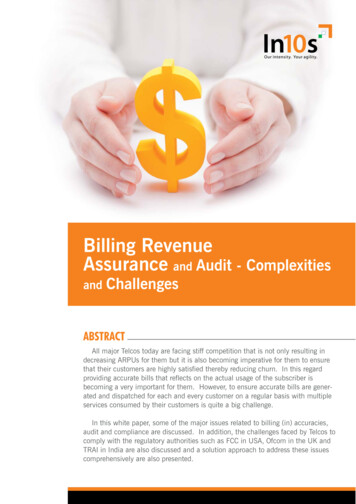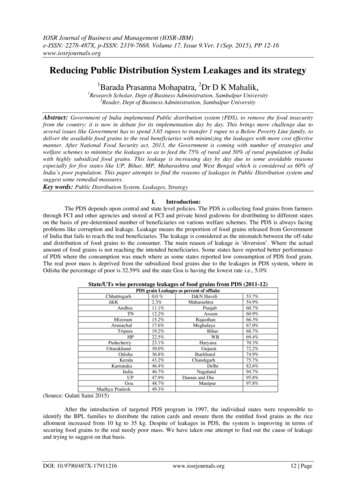
Transcription
IOSR Journal of Business and Management (IOSR-JBM)e-ISSN: 2278-487X, p-ISSN: 2319-7668. Volume 17, Issue 9.Ver. I (Sep. 2015), PP 12-16www.iosrjournals.orgReducing Public Distribution System Leakages and its strategy1Barada Prasanna Mohapatra, 2Dr D K Mahalik,1Research Scholar, Dept of Business Administration, Sambalpur University2Reader, Dept of Business Administration, Sambalpur UniversityAbstract: Government of India implemented Public distribution system (PDS), to remove the food insecurityfrom the country; it is now in debate for its implementation day by day. This brings more challenge due toseveral issues like Government has to spend 3.65 rupees to transfer 1 rupee to a Below Poverty Line family, todeliver the available food grains to the real beneficiaries with minimizing the leakages with more cost effectivemanner. After National Food Security act, 2013, the Government is coming with number of strategies andwelfare schemes to minimize the leakages so as to feed the 75% of rural and 50% of rural population of Indiawith highly subsidized food grains. This leakage is increasing day by day due to some avoidable reasonsespecially for five states like UP, Bihar, MP, Maharashtra and West Bengal which is considered as 60% ofIndia’s poor population. This paper attempts to find the reasons of leakages in Public Distribution system andsuggest some remedial measures.Key words: Public Distribution System, Leakages, StrategyI.Introduction:The PDS depends upon central and state level policies. The PDS is collecting food grains from farmersthrough FCI and other agencies and stored at FCI and private hired godowns for distributing to different stateson the basis of pre-determined number of beneficiaries on various welfare schemes. The PDS is always facingproblems like corruption and leakage. Leakage means the proportion of food grains released from Governmentof India that fails to reach the real beneficiaries. The leakage is considered as the mismatch between the off-takeand distribution of food grains to the consumer. The main reason of leakage is „diversion‟. Where the actualamount of food grains is not reaching the intended beneficiaries. Some states have reported better performanceof PDS where the consumption was much where as some states reported low consumption of PDS food grain.The real poor mass is deprived from the subsidized food grains due to the leakages in PDS system, where inOdisha the percentage of poor is 32.59% and the state Goa is having the lowest rate i.e., 5.0%State/UTs wise percentage leakages of food grains from PDS ndiaUPGoaMadhya PradeshPDS grain Leakages as percent of offtake0.0 %D&N 46.7%Nagaland47.9%Daman and (Source: Gulati Saini 2015)After the introduction of targeted PDS program in 1997, the individual states were responsible toidentify the BPL families to distribute the ration cards and ensure them the entitled food grains as the riceallotment increased from 10 kg to 35 kg. Despite of leakages in PDS, the system is improving in terms ofsecuring food grains to the real needy poor mass. We have taken one attempt to find out the cause of leakageand trying to suggest on that basis.DOI: 10.9790/487X-17911216www.iosrjournals.org12 Page
Reducing Public Distribution System Leakages and its strategyII.Literature Review:As per the 2011 census, the population of Odisha was 41947358, where the off take in 2011-12 was2058000 tones. The five states like UP, Tamilnadu, Maharashstra, West Bengal and Andhra Pradesh getting46.93% of total PDS off take but other states getting the rest of the food grains (Kavita 2014). There is a hugeregional disparity in distributing food grain where some states are getting maximum and some states are gettingvery less portion of PDS food grain, (Swaminathan 2000). Mishra (2008) pointed out that 58% subsidized foodgrains from central pool do not reach the real needy families due to leakage. The interstate variation can beminimized by distributing the food grains on the basis of size of population and its requirements, (Kavita, 2014).In order to deliver 5 kg per person per month the Government will have to allocate 8.3 kg per person per monthat subsidized price which will increase the real expenditure of the Government, (Dipa sinha, 2012). The idea ofcash transfer to the account of PDS beneficiaries will reduce the involvement of physical grains and a choice tothe user between cash and grain, (Gulati Saini 2015). The cash transfer can be a problem as in the survey it wasfound that , buying ration with money would entail first going to bank and then to the market for purchasing thefood grains, would result in wastage of money and time as both are far away from the respondent‟s place,(Ankita Aggarwal 2011). Gulati saini (2015) has pointed out the leakage in PDS by comparing the supply ofgrains and demand/ consumption of grains. Praveen Jha (2013) has done an analysis of financial provision toensure food security for all in the country. The current PDS can improve the food consumption but not sufficientto overcome the problem of malnutrition in India, (Radhakrishna Reddy, 2002). As per Khera (2011), initiallythe percentage of food grain leakage was 24% then 54% grains leaked during 2004-05 and at the end of theperiod 44% of PDS grain was diverted in all over the India. In 1993-94, about 24.1% population was using thePDS rice and wheat , where as in 2011-12, it was increased to 45.6% of Indian population,i.e, the averageconsumption per household per month in 1993-94 increased from 4.58 kg to 9.56 kg in 2011-12, (DeepankarBasu, Debarshi 2014). Kotwal et al (2011) pointed out that the states procurement and distribution system is infault where it is being argued that the poor should be provided cash through biometric cards, they can purchasefood grains at market price. Mihika (2013) in one of the survey on koraput district of Odisha found that, 61% ofhouseholds have access to PDS out of which 38% BPL card holders and 62% having other cards and the majorproblem was due to the „exclusion error‟, i.e, maximum households are deprived from PDS access. Lack ofaccess to FPSs is very important in rural states. In 2001, the state Chhattisgarh granted licenses to privateowners under the Sarvajanik Nagrik Poorti Vitran (SNPV) scheme resulting the number of FPSs becamedoubled between 2001 and 2004, (Krishnamurty, Pathania and Tandon 2014). The impact of PDS on riralpoverty is very low as (Dreze Jean 2013) in his studty compared and calculated the impact of food grainpurchase from PDS and the open market. The reduction in food grain subsidy will decrease the market price offfod grain,resulting the PDS users will not switch their purchasing habit from PDS,(Ramaswami,Balakrishnan2002). Both the inclusion and Exclusion error is important. The problem is to identifying the BPL householdswho should be included in the PDS transactions.(Sharan 2011).Case Analysis: We have done the analysis on Odisha, by taking the views of ten respondents of differentvillages of Dhenkanal District through questionnaire (Annexure-1). We have taken some parameters to judge theleakage in Odisha.Govt. Level problems for leakage1. Regional disparities in PDS allocation2. Monopoly in distributing the ration cards.3. No vigilance committee and courts.4. Distributing to APL families more than the BPL families.5. Lost due to storage capacity.6. Lack of digitization of PDS.7. Not keeping proper track of food grains carrying vehicles.FPS level problems for leakage1. Diversion of food grains in the open market.2. Duplicate cards/ bogus cards.3. Misappropriation in weight during delivery.We have applied Friedman Two-way ANOVA in our analysis. Milton Friedman, an economist andnoble laureate introduced the test in 1937. It is well known as “friedman ANOVA”. The test is widely used asthe computation is very easy where the normality of population sample is not required. This test is used foranalyzing the ordinal scaled responses given to several attributes or elements by „n‟ numbers of objects orindividuals. The variables are the ordinal scaled variables and the sample size can be any.DOI: 10.9790/487X-17911216www.iosrjournals.org13 Page
Reducing Public Distribution System Leakages and its strategyProcedure:1. Formulate hypothesis of no difference in the ranking of different treatments (columns) by different elements(blocks).2. Ensure that the ranks are assigned by each element across all the treatments. If the responses to treatmentswere measured in numerical scores (rather than ranks), they need to be ranked first for each blockseparately.3. Sum up the ranks formed for each treatment (Column).4. Square the sum of ranks obtained for each treatment (Column).5. Apply the Friedman statistical formula.Where N number of blocks, that is number of rowsK number of treatments, that is number of columnsR Sum of ranks in the jth treatment group.III.Analysis:Using a sample of 25 PDS users, it was decided to find out the major factors influencing the leakage inPDS. Ten factors such as regional disparities on PDS allocation (RDA), diversion of food grains in open market(DFOM), lack of storage capacity (LSC), Not keeping proper records (NKPR), no vigilance committee andcourt (NVCC), Monopoly in distributing the ration card (MDRC), Distributing to APL families more than theBPL families (DAFTBF), Lack of digitization of PDS (LDP), Duplicate cards/ bogus cards (DC/BC),Misappropriation in weight during delivery (MWDD) were identified and presented to those 25 respondentswho were asking to rank order the major factors that influence the leakage in PDS. They were told to assignrank „1‟ to the factor that was most influential, rank „2‟ for more influential and so on for 10 factors.Factors influencing the leakages in PDS(Source: Data from the questionnaire)Is there any significance difference among the factors influencing the leakages in PDS, i.e. can we identify thefactors that are most likely to influence the leakage in PDS.Step-1Formulate a null and an alternate hypothesis:Ho There is no significance difference among the factors influencing the leakage in PDS.H2 There is a significance difference among the factors influencing the leakage in PDS.DOI: 10.9790/487X-17911216www.iosrjournals.org14 Page
Reducing Public Distribution System Leakages and its strategyStep-2Assign ranks for each treatment by rows. The present data itself is in the form of ranks awarded by each firm(row) across the factors (column). Thus, there is no need for us to convert the data into ranks again. Therefore,let us retain the same ranking pattern.Step-3Sum the ranks formed for each treatment and square them as shown in the following table:Ranks assignedRespondentsRespondent 1Respondent 2Respondent 3Respondent 4Respondent 5Respondent 6Respondent 7Respondent 8Respondent 9Respondent 10Respondent 11Respondent 12Respondent 13Respondent 14Respondent 15Respondent 16Respondent 17Respondent 18Respondent 19Respondent 20Respondent 21Respondent 22Respondent 23Respondent 24Respondent late the Friedman statistic value: 12/25x10(10 1) x (234003)-3x25(10 1) 12/2750x234003-825 0.004363x234003-825 1020.96-825 195.96Step-5Calculate the Friedman critical value. We have the number of columns (k) that is 10, we can refer totable 1 found, which gives the chi-square critical value. The table value for 10 per cent level of significance for(k-1) degrees of freedom (that is, 9) is 14.648.DOI: 10.9790/487X-17911216www.iosrjournals.org15 Page
Reducing Public Distribution System Leakages and its strategyStep-6Compare the calculated and critical Friedman value and make a decision. Since the calculatedFriedman statistic of 195.96 is greater than critical value of 14.648, we conclude by stating that the ranking offactors assigned by sample in influencing the leakage in PDS is significantly different. That is, at least onefactor is most influential in the leakage in PDS. Hence, we reject the null hypothesis of no significant differencein the factors influencing the leakage in PDS. Looking at the Rj scores, we find that Diversion of food grains inthe open market (DFOM) is the most influential factor (because the R value is too small compare to R value ofother columns) in the decision of leakage in PDS.IV.ConclusionThe aim of this article was to highlight the corruption in terms of leakages in Public Distributionsystem in the state of Odisha. The survey made on seven villages of Dhenkanal District like Bhapur, Nuagan,sankarpur, ranapasi, Mangalpur, khajuria, Indipur. During the survey the data was collected throughquestionnaire from the respondents from the said villages and the conclusion drawn from this it that the leakagesis due to the diversion of food grains to the open market where the actual PDS users are not getting the actualfood grains at right amount at right time. Another problem observed that the losses of food grains due to the lackof storage capacity in respective areas and to the some extend the leakage is happening during the transit of foodgrains from the Government to the FPSs. So we are suggesting to keep restriction on the appointment of dealersto ensure the actual food grains coming from the central pool should reach to the actual beneficiaries. Thereshould be proper storage capacity to minimize the losses of food grains and properly identifying the BPLfamilies to decrease the duplicate cards in the market which is the main reason of diversion of food grains to theopen market. To keep a proper track of requirements of different areas for better allotment resulting minimize inthe leakage of food 19].[20].Aggarwal Ankita (2011): The PDS in rural Orissa Against the grain”, Economic & political weekly, vol 46, no 36Bhalla, G.S. and Gurmail Singh (2001), Indian Agriculture: Four Decades of Development, Sage Publications, N. DelhiB .Ramaswami, P.Balakrishnan 2002, „Food prices and the efficiency of Public intervention: the case of the Public DistributionSystem in India”, Food policy 27, 419-436.Chatterjee, Mihika (2013), „An Improved PDS in a “Reviving” State: Food Security in Koraput, Odisha‟, mimeo,Oxford Poverty and Human Development Initiative,Oxford University; forthcoming in Economic and Political Weekly. Deepankar.B, Debarshi.D, 2014,”Social Hierarchies and PublicDistribution of food in rural India.Dreze Jean (2013): “ From the Granary to the plate”, The Hindu, 1 August.Gulati, A and S Saini (2015): “Leakages from the Public Distribution System (PDS) and the way forward”‟ Working paper 294,Indian council for research on international relations, New Delhi.Himanshu (2013):, “PDS: A story of changing states”, Mint, 7 AugustKavita,2014,”Evaluation pf Public Distribution System in India”, International journal of advanced research in Management andsocial science, vol.3,No.4, April 2014.Kotwal,A.,Murugkar,M,& Ramaswami,B (2011),PDS forever? Economic & Political weekly,46(21), 72-76.Khera, R, (2011). Trends in diversion of PDS grain. Economic and Political Weekly, 46(21), 106-114Krishnamurthy, Prasad, Vikram Pathania, and Sharad Tandon . 2014. “Public Distribution System Reforms andConsumption in Chhattisgarh” Economic and Political Weekly 49 (8) 74-81.Mishra, Manoj Kumar (2008), “Woes and Worries of Public Distribution System,” Yojana, July, pp. 43-46.Praveen.J,Nilachala.A,2013,Securing food for all,it is really difficult to afford, Economic & Political weekly,January 26,2013.Planning Commission. (2013). Press Note on Poverty Estimates, 2011-12 (No. id: 5421)Radhakrishna (2002) “Food and Nutrition Security” in Kirit S. Parikh and R. Radhakrishnas (eds.) India Development Report,2002, Oxford University Press.Swaminathan, Madhura (2000), Weakening Welfare, The Public Distribution of Food in India, Left Word Books, New Delhi.Sinha, Dipa. 2012. “Why the NFSA Will Not Ensure Nutrition Security.” Centerfor Legislative Research andAdvocacy Policy Brief Series No. 15Sharan M R,2011, Identifying BPL households: A comparison of competing approches , Vol. XLVI,No 26&27, Economic &Politiocal Weekly, June 25,2011.Odisha State Civil Suppliers Corporation LtdDOI: 10.9790/487X-17911216www.iosrjournals.org16 Page
IOSR Journal of Business and Management (IOSR-JBM) e-ISSN: 2278-487X, p-ISSN: 2319-7668. Volume 17, Issue 9.Ver. . Dept of Business Administration, Sambalpur University Abstract: Government of India implemented Public distribution system . (NVCC), Monopoly in distributing the ration card (MDRC), Distributing to APL families more than the .

